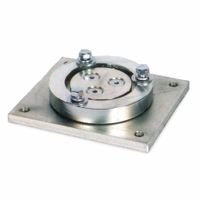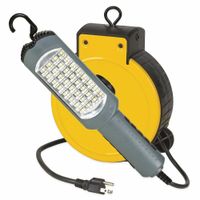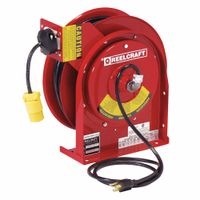Call +(254) 703 030 000 / 751 483 999 / 721 704 777
- Home
- Electrical
- Extension Cords Power Strips Cord Reels
- Extension Cord Reels
.....Read More
Frequently Asked Questions
What is the best extension cord reel for outdoor use?
The best extension cord reel for outdoor use is the ReelWorks Extension Cord Reel. This reel is highly regarded for its durability, functionality, and safety features, making it ideal for outdoor environments. It typically comes with a heavy-duty 12-gauge, 3-prong SJTW cable, which is resistant to moisture, abrasion, and sunlight, ensuring longevity and reliability in various weather conditions.
The ReelWorks Extension Cord Reel often features a retractable design with a locking mechanism, allowing users to extend and lock the cord at any desired length, reducing tangles and ensuring easy storage. Its swivel bracket enables 180-degree rotation, providing flexibility and ease of use in different outdoor settings.
Safety is a priority with this reel, as it usually includes a built-in circuit breaker to protect against overloads, ensuring the safety of connected devices and preventing potential hazards. The reel is often equipped with a triple tap connector, allowing multiple devices to be powered simultaneously, which is particularly useful for outdoor projects or events.
Additionally, the ReelWorks Extension Cord Reel is known for its robust construction, often featuring a durable polypropylene case that can withstand the rigors of outdoor use. Its portability and ease of installation make it a convenient choice for both residential and commercial applications.
Overall, the ReelWorks Extension Cord Reel combines practicality, safety, and durability, making it a top choice for those seeking a reliable extension cord reel for outdoor use.
How do I choose the right length for an extension cord reel?
To choose the right length for an extension cord reel, consider the following factors:
1. **Distance**: Measure the distance from the power source to the location where the power is needed. Ensure the cord length exceeds this distance to allow for flexibility and ease of use.
2. **Environment**: Consider the environment where the cord will be used. For outdoor or large spaces, longer cords (50-100 feet) are often necessary. For indoor or smaller spaces, shorter cords (25-50 feet) may suffice.
3. **Power Needs**: Assess the power requirements of the devices you plan to connect. Longer cords can lead to voltage drop, which may affect the performance of high-power devices. Choose a cord with an appropriate gauge to minimize this effect.
4. **Storage and Portability**: Longer cords can be bulkier and harder to store. Consider a reel with a built-in winding mechanism for easy storage and transport.
5. **Flexibility**: If you need to move around frequently, a longer cord provides more flexibility. However, ensure it doesn’t become a tripping hazard.
6. **Future Needs**: Anticipate future needs. If you expect to use the cord in different settings or for various tasks, opt for a longer length to accommodate potential changes.
7. **Budget**: Longer cords are generally more expensive. Balance your needs with your budget to find a suitable option.
By evaluating these factors, you can select an extension cord reel that meets your specific requirements, ensuring safety, efficiency, and convenience.
Are self-retracting cord reels better than manual ones?
Self-retracting cord reels offer several advantages over manual ones, primarily in terms of convenience, safety, and efficiency.
Convenience is a significant factor. Self-retracting cord reels automatically wind the cord back into the reel with minimal effort, saving time and reducing the physical strain associated with manually winding cords. This feature is particularly beneficial in environments where cords are frequently extended and retracted, such as workshops or construction sites.
Safety is another critical advantage. Self-retracting reels help prevent tripping hazards by ensuring that cords are neatly stored when not in use. This reduces the risk of accidents caused by loose or tangled cords on the floor. Additionally, the automatic retraction mechanism often includes a locking feature that allows users to extend the cord to a desired length and keep it secure, preventing unwanted retraction during use.
Efficiency is enhanced as self-retracting reels streamline operations by reducing the time spent managing cords. This can lead to increased productivity, especially in professional settings where time is a valuable resource. The consistent tension provided by the retraction mechanism also helps maintain the cord's integrity, potentially extending its lifespan compared to cords that are manually wound and may suffer from uneven tension and wear.
However, self-retracting cord reels can be more expensive than manual ones and may require maintenance to ensure the retraction mechanism functions properly. In contrast, manual reels are generally simpler, less costly, and have fewer components that can fail.
In summary, self-retracting cord reels are often better than manual ones for those prioritizing convenience, safety, and efficiency, despite the higher initial cost and potential maintenance needs.
Can extension cord reels be used in hazardous locations?
Extension cord reels are generally not recommended for use in hazardous locations unless they are specifically designed and certified for such environments. Hazardous locations are areas where there is a potential for fire or explosion due to the presence of flammable gases, vapors, dust, or fibers. These areas require equipment that meets strict safety standards to prevent ignition sources.
Standard extension cord reels may not have the necessary features to prevent sparks or overheating, which could ignite flammable substances. In hazardous locations, equipment must comply with regulations such as the National Electrical Code (NEC) in the United States, which outlines the requirements for electrical installations in these environments.
For use in hazardous locations, extension cord reels must be rated for the specific class and division of the area. This includes being constructed with materials that prevent sparking, having sealed or explosion-proof enclosures, and being tested and certified by recognized safety organizations like Underwriters Laboratories (UL) or the Canadian Standards Association (CSA).
If an extension cord reel is needed in a hazardous location, it is crucial to select one that is explicitly labeled for such use. These reels will have specific markings indicating their suitability for hazardous environments, such as Class I, Division 1 or 2, or Class II, Division 1 or 2, depending on the type of hazard present.
In summary, while standard extension cord reels should not be used in hazardous locations, there are specialized reels available that meet the necessary safety standards for such environments. Always ensure compliance with local regulations and consult with safety professionals when selecting equipment for hazardous areas.
How do I mount an extension cord reel on a wall or ceiling?
1. **Choose Location**: Select a suitable spot on the wall or ceiling, ensuring it is near a power outlet and provides easy access for use.
2. **Gather Tools and Materials**: You will need a drill, screws, anchors (if mounting on drywall), a screwdriver, a stud finder, a level, and a pencil.
3. **Find Studs**: Use a stud finder to locate studs in the wall or ceiling. Mark the stud locations with a pencil. If mounting on drywall without studs, use appropriate anchors.
4. **Position the Reel**: Hold the extension cord reel against the wall or ceiling at the desired location. Use a level to ensure it is straight.
5. **Mark Drill Holes**: Mark the spots where the mounting holes on the reel align with the studs or where you will place anchors.
6. **Drill Pilot Holes**: Drill pilot holes at the marked spots. If using anchors, drill holes slightly smaller than the anchor size.
7. **Insert Anchors**: If not mounting directly into studs, insert drywall anchors into the drilled holes.
8. **Mount the Reel**: Align the reel’s mounting holes with the drilled holes or anchors. Use screws to secure the reel to the wall or ceiling. Ensure the screws are tight and the reel is stable.
9. **Test Stability**: Gently pull on the reel to ensure it is securely mounted and does not wobble.
10. **Connect Power**: Plug the extension cord reel into the power outlet.
11. **Test Functionality**: Pull out and retract the cord to ensure smooth operation.
12. **Safety Check**: Ensure the cord does not obstruct pathways and is safely stored when not in use.
What are the benefits of using a lighted cord reel?
A lighted cord reel offers several benefits that enhance convenience, safety, and efficiency in various settings:
1. **Enhanced Visibility**: The integrated light feature provides illumination, making it easier to see in dimly lit areas. This is particularly useful in garages, workshops, or outdoor settings at night, reducing the risk of accidents.
2. **Safety**: The lighted end of the cord indicates when the power is on, preventing accidental shocks or equipment damage. This visual cue ensures users are aware of the power status, enhancing overall safety.
3. **Organization**: Cord reels help in neatly storing and organizing extension cords, preventing tangles and knots. This organization reduces wear and tear on the cords, extending their lifespan.
4. **Portability**: Many lighted cord reels are designed to be portable, allowing easy transportation from one location to another. This is beneficial for professionals who need to move equipment frequently.
5. **Space-Saving**: By keeping cords neatly wound, lighted cord reels save space in storage areas. This is particularly advantageous in small workshops or garages where space is at a premium.
6. **Durability**: High-quality lighted cord reels are often made from durable materials that withstand harsh conditions, making them suitable for both indoor and outdoor use.
7. **Ease of Use**: The retractable feature of many cord reels allows for easy extension and retraction of the cord, minimizing effort and time spent on setup and takedown.
8. **Versatility**: Lighted cord reels are available in various lengths and power capacities, catering to different needs, from household tasks to heavy-duty industrial applications.
9. **Professional Appearance**: Using a cord reel can give a more professional and organized appearance to workspaces, which can be important for businesses and contractors.
Overall, lighted cord reels combine functionality with safety features, making them a valuable tool for both personal and professional use.
How do I maintain and care for an extension cord reel?
To maintain and care for an extension cord reel, follow these steps:
1. **Regular Inspection**: Frequently check the cord for any signs of wear, fraying, or damage. Inspect the plug and socket for any signs of burning or corrosion.
2. **Proper Storage**: Store the reel in a dry, cool place away from direct sunlight and moisture to prevent damage to the cord and reel mechanism.
3. **Avoid Overloading**: Ensure the cord is not used beyond its rated capacity. Overloading can cause overheating and damage.
4. **Correct Unwinding**: Fully unwind the cord before use to prevent overheating. Using the cord while coiled can lead to heat buildup.
5. **Clean Regularly**: Wipe the cord and reel with a damp cloth to remove dust and debris. Ensure the reel is dry before storing.
6. **Lubrication**: Occasionally lubricate the reel mechanism with a suitable lubricant to ensure smooth operation and prevent rust.
7. **Avoid Sharp Bends**: Do not bend the cord sharply or wrap it tightly around the reel, as this can cause internal wire damage.
8. **Use in Safe Environments**: Avoid using the cord in wet or hazardous environments unless it is specifically rated for such conditions.
9. **Reel Mechanism Care**: If the reel has a retractable mechanism, ensure it functions smoothly. Do not force the cord back into the reel; guide it gently.
10. **Repair or Replace**: If any part of the cord or reel is damaged, repair it promptly or replace it to ensure safety and functionality.
11. **Labeling**: Clearly label the reel with its capacity and any specific usage instructions to prevent misuse.
By following these steps, you can extend the life of your extension cord reel and ensure it operates safely and efficiently.





